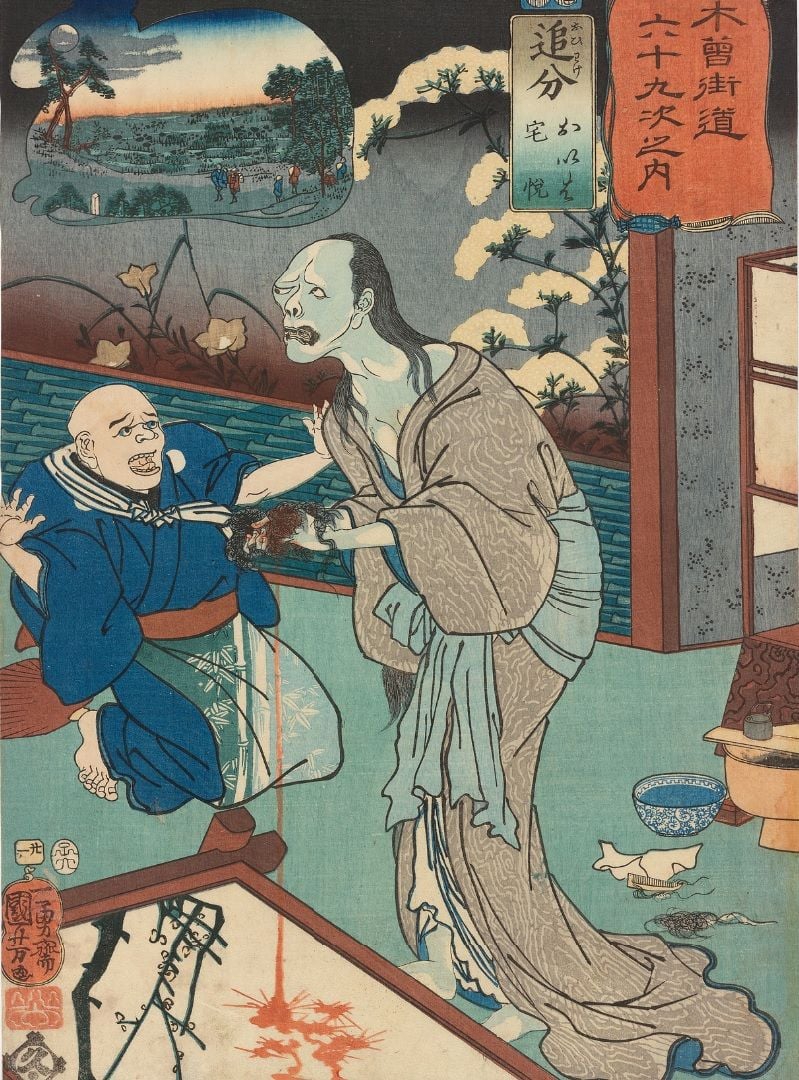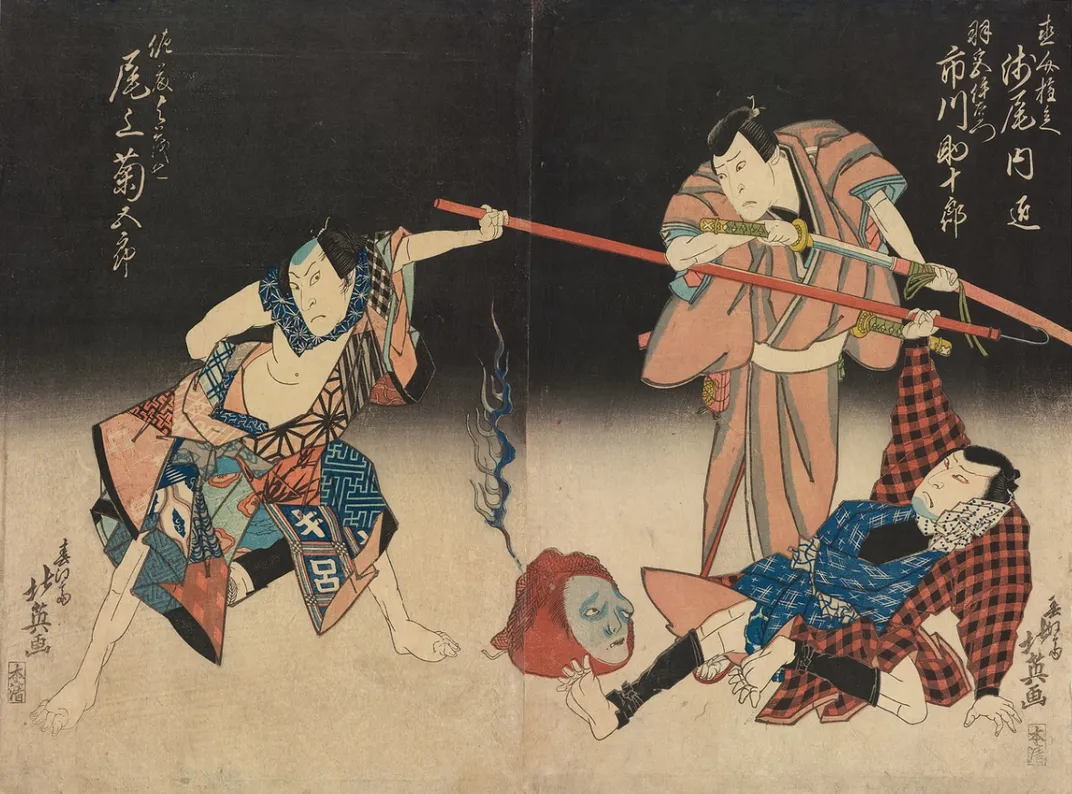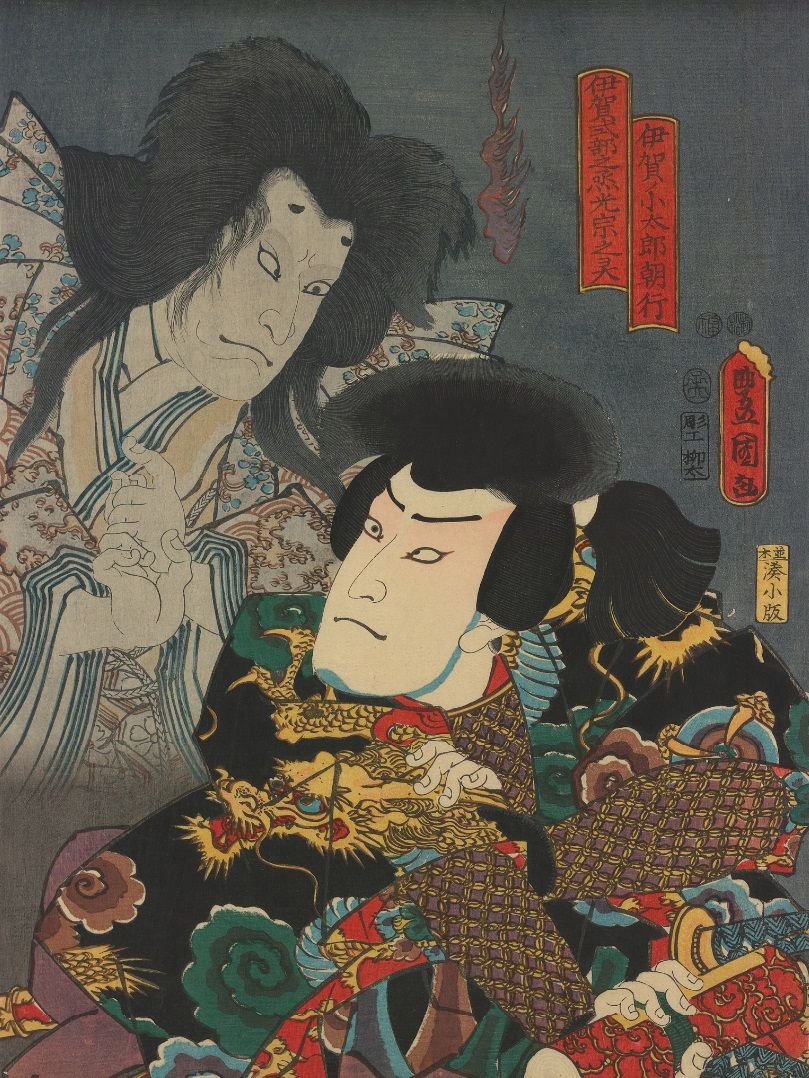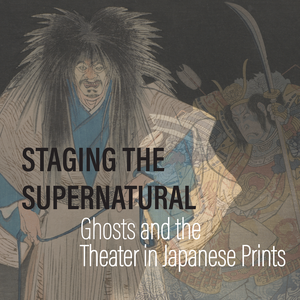Spend Halloween With Gruesome Ghosts
Celebrate the scary season with ghostly Japanese prints from the upcoming book “Staging the Supernatural”
:focal(635x466:636x467)/https://tf-cmsv2-smithsonianmag-media.s3.amazonaws.com/filer_public/c7/ad/c7addb93-2635-467b-ac9c-6167959ec9c4/ichikawa_kodanji_iv_as_the_ghost_rei.jpg)
Ghost stories are deeply embedded in Japan’s culture; the country’s many stories are reinforced in the narratives of books, a ready source for plays in the kabuki theater and an inspiration for artists in the world of prints. As a collector of Japanese woodblock prints, I am fascinated by these stories that are, in some cases, centuries old yet never lost to time, instead being retold into the present day. I love matching an eighteenth- or nineteenth-century ukiyo-e print to a twentieth-century print to compare how these tales are reimagined in contemporary times. Once I purchased my first ghost print, collecting in this genre became addictive. The stories of murder, betrayal, greed, bravery, and revenge enacted in these prints are palpable, and favorites are told and retold time and again.

Who could not respond to the story of a faithful wife, Oiwa, poisoned by her husband so he can marry his rich neighbor? The poison causes her hair to fall out in clumps and her eye to swell and bulge until her husband ties her to a board and throws her in a river to die. One day when he returns to the river, both the board and Oiwa rise from the water, and from that day forward her ghost will haunt him as he moves from village to village, until he dies on Snake Mountain. The imagery of Oiwa holding clumps of her hair in her hand and of her bulging eye became iconic symbols used in the many graphic prints that tell her sad story. —Pearl Moskowitz
Bandō Mitsugorō III as the Maiden of Dōjōji
/https://tf-cmsv2-smithsonianmag-media.s3.amazonaws.com/filer_public/39/01/3901f173-089a-47d1-ac08-df39daa9a370/actor_bando_mitsugoro_iii_as_the_maiden_of_dojo-ji.jpg)
The performance depicted here is from a production of The Maiden of Dōjōji, Tie-dyed in the Capital (Kyōganoko musume Dōjōji) at the Nakamura theater in Edo, which opened in the 3rd month of 1816. The role of Kiyohime was played by Bandō Mitsugorō III (1775–1831), shown raising one part of the costume to reveal her demonic mask and wearing robes with a tessellating diamond pattern that suggests the scales of a serpent. Crouched under Mitsugorō’s left arm, a stagehand is ready to assist in the removal of costume elements. As a symbolic contrast to Kiyohime’s ferocious demonic form, the blooming cherry blossoms surrounding her are associated with young female beauty, thereby recalling her original human state and the body of the female pilgrim she has now possessed. Although the print version is static and cannot show the actor’s costume changes in action, this use of iconography is able to suggestively capture the different stages of transformation within a single image.
Asao Takumi I as Naosuke Gonbei, Ichikawa Sukejūrō I as Hamiya Iemon (R), and Onoe Kikugorō III as Satō Yomoshichi (L), with Oiwa’s disembodied head in the center

In this disturbing diptych, Oiwa’s disembodied head lies on the ground by her wicked husband, Iemon. Drawing his sword, Iemon stands upright between his associate, Naosuke Gonbei, on the right and Oiwa’s brother-in-law, Satō Yomoshichi, on the left. There are many variations of the Yotsuya kaidan story, with some scenes performed less often than others or certain techniques developed only for particular productions, and woodblock prints reflect this variety. In this rarely performed scene, Oiwa’s dismembered head has rolled out of a container—the blue spirit flame (shinka) rising from the top making it clear the head is supernaturally animated. There are multiple angles of conflict here—not only the tension between Iemon and Oiwa but also between Gonbei and Yomoshichi. Since the beginning of the play, Gonbei has been lusting after Oiwa’s sister, Osode, who is married to Yomoshichi. Iemon convinces Oiwa to remain with him so he can seek vengeance against her father’s murderer, and Osode agrees to divorce Yomoshichi and marry Gonbei for the same reason. (The sisters are unaware that the murderer is actually Iemon.) Gonbei’s villainous nature is indicated by the red makeup lining his eyes and his cowardly posture as he falls back from Oiwa’s reproachful glare. In contrast, Yomoshichi’s powerful stance and stylish clothing make him an appealing figure, and it is he who kills Iemon in the final act, with the help of supernatural assistance by Oiwa. In each performance of this play, the same actor plays both Yomoshichi and Oiwa, providing a multilayered tension between the characters. Onoe Kikugorō III was particularly renowned for his ability to perform multiple roles in the same production through rapid costume and makeup changes, which thrilled the audience. A dummy Oiwa head allowed both characters to appear onstage at the same time during this sequence.
This print depicts a performance of Yotsuya kaidan that opened at the Wakadayū theater in Osaka in the 3rd month of 1831. In general, the Osaka style of kabuki is characterized as wagoto, or “gentle style,” in comparison to the aragoto, or “rough stuff,” manner in which Edo-style kabuki was performed. As a visual analogue, Osaka actor prints are comparatively less crowded with cartouches and compositional elements, and the artists paid more attention to depicting the actual physiognomies and emotional states of the actors rather than their stylized and overblown Edo equivalents. Devoid of extraneous elements, the deep black background makes this a relatively refined design, despite the gruesomeness of the scene.
Nakamura Fukusuke I as Iga no Kotarō Tomoyuki (R) and Nakamura Utaemon IV as the ghost of Iga Shikibunojō Mitsumune

The eerie sight of Iga Shikibunojō Mitsumune’s ghost looming over the shoulder of the younger man is made even more haunting by the knowledge that the actor playing the ghost, Nakamura Utaemon IV (1798–1852), had died two months prior to this print’s publication. His spectral status is clear from the muted colors used to render both his ghostly form and the shinka fame alongside his head. Black eye makeup is used for ghosts to make the actor’s eyes appear larger; in this case, it amplifies Utaemon’s exaggerated facial gesture of concentration made by crossing only one of his eyes, a talent that is highly valued among kabuki actors. He is performing a ritual hand movement used by magicians to cast spells. These gestures are also used in Buddhist iconography and would perhaps have been seen as another reminder that Utaemon had already entered the afterlife. As Utaemon was a major celebrity, his death would have been common knowledge among theater fans.
The scene is from the play Record of Honorable and Benevolent Rulers (Meiyo jinsei roku), which opened at the Ichimura theater in Edo in the 7th month of 1852. It is a dramatized version of a very successful serialized novel by Kyokutei Bakin (1767–1848), The Story of Aoto Fujitsuna (Aoto Fujitsuna moryō-an), published between 1811 and 1812 with illustrations by Katsushika Hokusai (1760–1849). The novel is partially based on a real-life historical figure, a magistrate named Ōka Tadasuke (1677–1752) who was known for his fair judgments. But how could this play be performed if a star actor had died before the production began? In fact, Utaemon’s part was played by a voice imitator, known as a kowairozukai. Although this tradition has died out in the age of voice and video recording, the talent for imitating famous kabuki actors’ voices was greatly appreciated as a form of entertainment in the Edo period. There were professional imitators who could step in for actors who were ill or otherwise unable to perform or who could offer a glimpse of the theater to establishments outside the offcially licensed theaters. There were also commercial publications aimed at general readers in the genre of kowairo, or “voice mimicry,” instructional guides on how to imitate the voices of well-known kabuki actors. Furnished with such a book (and some practice), household members could entertain one another by recreating scenes they may have seen at the theater or in woodblock prints. In this case, the kowairozukai had an additional effect, with Utaemon’s voice seemingly speaking out from beyond the grave. The light dusting of glittering mica along the top of the print adds to the eerie otherworldliness of this performance.
Meet even more ghosts and demons this Halloween with Staging the Supernatural: Ghosts and the Theater in Japanese Prints (published by Smithsonian Books, available October 31). Visit Smithsonian Books’ website to learn more about its publications and a full list of titles.
Excerpt from Staging the Supernatural: Ghosts and the Theater in Japanese Prints © 2023 by Smithsonian Institution

